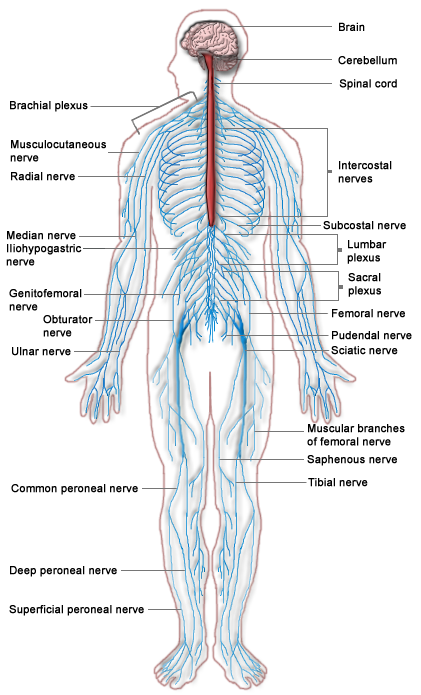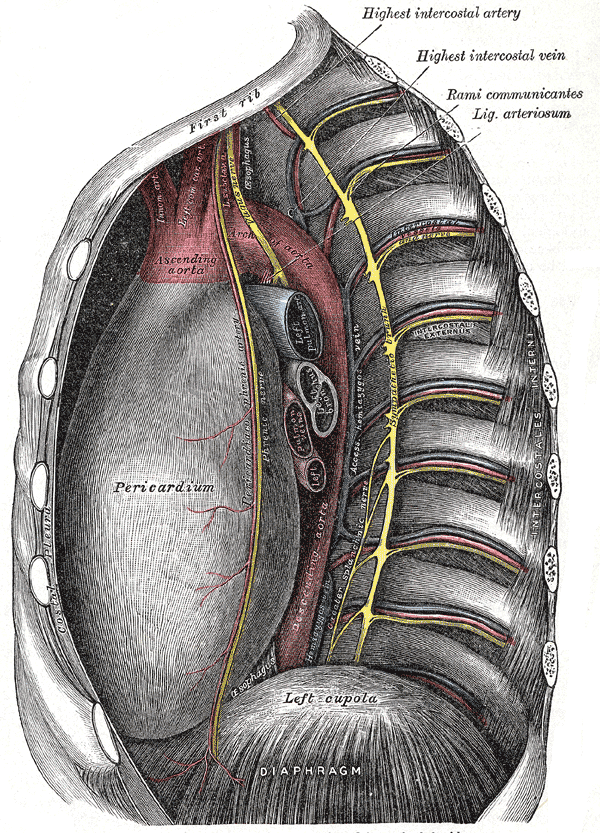Intercostal nerves
 From Wikidoc - Reading time: 4 min
From Wikidoc - Reading time: 4 min
Editor-In-Chief: C. Michael Gibson, M.S., M.D. [1]
Overview[edit | edit source]
The intercostal nerves are the anterior divisions (rami anteriores; ventral divisions) of the thoracic spinal nerves from T1 to T11.
Each nerve is connected with the adjoining ganglion of the sympathetic trunk by a gray and a white ramus communicans. The intercostal nerves are distributed chiefly to the thoracic pleura and abdominal peritoneum, and differ from the anterior divisions of the other spinal nerves, in that each pursues an independent course without plexus formation.
The first two nerves supply fibers to the upper limb in addition to their thoracic branches; the next four are limited in their distribution to the parietes of the thorax; the lower five supply the parietes of the thorax and abdomen. The 7th intercostal nerve terminates at the xyphoid process, at the lower end of the sternum. The 10th intercostal nerve terminates at the umbilicus. The twelfth (subcostal) thoracic is distributed to the abdominal wall and groin.
The 1st Thoracic Nerve[edit | edit source]
The anterior division of the first thoracic nerve divides into two branches: one, the larger, leaves the thorax in front of the neck of the first rib, and enters the brachial plexus; the other and smaller branch, the first intercostal nerve, runs along the first intercostal space, and ends on the front of the chest as the first anterior cutaneous branch of the thorax.
Occasionally this anterior cutaneous branch is missing.
The first intercostal nerve rarely gives off a lateral cutaneous branch; but sometimes sends a small branch to communicate with the intercostobrachial.
From the second thoracic nerve it frequently receives a connecting twig, which ascends over the neck of the second rib.
The Upper Thoracic Nerves: 2nd-6th[edit | edit source]
The anterior divisions of the second, third, fourth, fifth, and sixth thoracic nerves, and the small branch from the first thoracic, are confined to the parietes of the thorax, and are named thoracic intercostal nerves.
They pass forward in the intercostal spaces below the intercostal vessels. At the back of the chest they lie between the pleura and the posterior intercostal membranes, but soon pierce the latter and run between the two planes of Intercostal muscles as far as the middle of the rib.
They then enter the substance of the Intercostales interni, and, running amidst their fibers as far as the costal cartilages, they gain the inner surfaces of the muscles and lie between them and the pleura.
Near the sternum, they cross in front of the internal mammary artery and Transversus thoracis muscle, pierce the Intercostales interni, the anterior intercostal membranes, and Pectoralis major, and supply the integument of the front of the thorax and over the mamma, forming the anterior cutaneous branches of the thorax; the branch from the second nerve unites with the anterior supraclavicular nerves of the cervical plexus.
Branches[edit | edit source]
Numerous slender muscular filaments supply the Intercostales, the Subcostales, the Levatores costarum, the Serratus posterior superior, and the Transversus thoracis. At the front of the thorax some of these branches cross the costal cartilages from one intercostal space to another.
- Lateral cutaneous branches (rami cutanei laterales) are derived from the intercostal nerves, about midway between the vertebræ and sternum; they pierce the Intercostales externi and Serratus anterior, and divide into anterior and posterior branches.
- The anterior branches run forward to the side and the forepart of the chest, supplying the skin and the mamma; those of the fifth and sixth nerves supply the upper digitations of the Obliquus externus abdominis.
- The posterior branches run backward, and supply the skin over the scapula and Latissimus dorsi.
The lateral cutaneous branch of the second intercostal nerve does not divide, like the others, into an anterior and a posterior branch; it is named the intercostobrachial nerve (Fig. 816). It pierces the Intercostalis externus and the Serratus anterior, crosses the axilla to the medial side of the arm, and joins with a filament from the medial brachial cutaneous nerve. It then pierces the fascia, and supplies the skin of the upper half of the medial and posterior part of the arm, communicating with the posterior brachial cutaneous branch of the radial nerve. The size of the intercostobrachial nerve is in inverse proportion to that of the medial brachial cutaneous nerve. A second intercostobrachial nerve is frequently given off from the lateral cutaneous branch of the third intercostal; it supplies filaments to the axilla and medial side of the arm.
The Lower Thoracic Nerves: 7th-11th[edit | edit source]
The Lower Thoracic Nerves: 12th[edit | edit source]
Anterior division[edit | edit source]
- See subcostal nerve
Lateral cutaneous branch[edit | edit source]
The lateral cutaneous branch of the last thoracic nerve is large, and does not divide into an anterior and a posterior branch.
It perforates the Obliqui internus and externus, descends over the iliac crest in front of the lateral cutaneous branch of the iliohypogastric, and is distributed to the skin of the front part of the gluteal region, some of its filaments extending as low as the greater trochanter.
See also[edit | edit source]
Additional images[edit | edit source]
-
Nervous system
-
Intercostal spaces, viewed from the left
-
Brachial plexus
External links[edit | edit source]
- Template:NormanAnatomy (Template:NormanAnatomyFig)
- Template:UMichAtlas - "Abdominal Wall, Dissection, Lateral View"
 KSF
KSF
